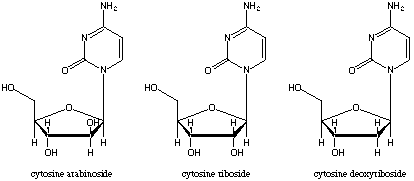
I never call it "cytarabine", so I'm not sure of the pronunciation. I know this compound as cytosine arabinoside, say site-oh-seen-a-RAB-en-oh-side, or call it ara C. The reason I call it this is because I learned about it as a DNA synthesis inhibitor because its structure is very similar to ribocytosine and deoxyribocytosine, base-sugar combinations needed to build RNA and DNA, respectively:

The nomenclature gets sort of confusing, note that I use "ribocytosine" and "cytosine riboside" to designate the same compound. The "-oside" means that a sugar has been added to the base. The base is the six-membered ring on top, in this case cytosine (the C in the A, T, G, C bases that make up DNA). The sugar is the five membered ring on the bottom. In the three compounds above, you have three sugars from left to right: arabinose, ribose, and deoxyribose. The specific placement and/or absence of the -OH groups makes a world of difference to the cell.
So, bases are hooked to sugars are called nucleosides. When the sugar is deoxyribose, they go on to build DNA. When the sugar is ribose, they go on to build RNA. When the sugar is arabinose, they . . . well, they don't do anything because they have the wrong sugar! In fact, if the sugar is arabinose, even more damage happens than just being there taking up space.
In the cell, cytosine riboside is converted to cytosine deoxyriboside with the help of a reductase enzyme. To do its work, the enzyme must bind to the cytosine riboside. Well, if cytosine arabinoside is present, the enzyme thinks that it is cytosine riboside, so it binds to it. However, since the -OH group is from the "wrong side of the ring", it simply is unable to reduce it, or change it to an -H to form cytosine deoxyriboside. Without cytosine deoxyriboside, the cell will not have a necessary building block for DNA and the cell will die.
Ara C is listed as an antineoplastic, an antimetabolite, antiviral, immunosuppressant. You might want to go to the Access Project to see what they have written about the side effects of Ara C. Nausea, again, is a common side effect. Your oncodoc may prescribe an antinausea medication to be given an hour before administration. Side effect list:
You should not give aspirin to a patient receiving ara C because it can cause gastric bleeding. Encourage a high liquid intake. Allopurinol may be prescribed by the doc to decrease uric acid levels.
I did not get a sheet from the hospital for this drug. Ara C is given by injection, either intrathecal (once in my son's ALL treatment) or subcutaneous. His dosage was 4 shots, one a day for four days. To eliminate a trip to the hospital, our nurse taught me how to give the shots. Fun. We use emla first, and as long as I hit the spot where we put the emla, it's okay :-) although he says it burns under his skin for a few minutes after injection. If you are administering this drug to your child, make sure you check the syringe before injection: we often found crystals in the syringe because the drug crashed out of solution and had to warm and mix the syringe carefully to get it all back into solution.
By the way, Ara C has a CA registry number of 147-94-4. Its CA name is 4-amino-1-beta-D-arabinofuranosyl-2(1H)-pyrimidinone or 1-beta-D-arabinofuranosylcytosine. It is also known as beta-cytosine arabinosid, aracytidine, Alexan, Arabitin, Aracytine, Cytarbel, Cytosar, or Udicil. It is a solid at room temperature which melts at 212-213 degrees centigrade and forms prisms when crystallized from 50% ethanol.